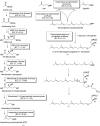Structural studies of geranylgeranylglyceryl phosphate synthase, a prenyltransferase found in thermophilic Euryarchaeota
- PMID: 32496216
- PMCID: PMC7271946
- DOI: 10.1107/S2059798320004878
Structural studies of geranylgeranylglyceryl phosphate synthase, a prenyltransferase found in thermophilic Euryarchaeota
Abstract
Archaea are uniquely adapted to thrive in harsh environments, and one of these adaptations involves the archaeal membrane lipids, which are characterized by their isoprenoid alkyl chains connected via ether linkages to glycerol 1-phosphate. The membrane lipids of the thermophilic and acidophilic euryarchaeota Thermoplasma volcanium are exclusively glycerol dibiphytanyl glycerol tetraethers. The first committed step in the biosynthetic pathway of these archaeal lipids is the formation of the ether linkage between glycerol 1-phosphate and geranylgeranyl diphosphate, and is catalyzed by the enzyme geranylgeranylglyceryl phosphate synthase (GGGPS). The 1.72 Å resolution crystal structure of GGGPS from T. volcanium (TvGGGPS) in complex with glycerol and sulfate is reported here. The crystal structure reveals TvGGGPS to be a dimer, which is consistent with the absence of the aromatic anchor residue in helix α5a that is required for hexamerization in other GGGPS homologs; the hexameric quaternary structure in GGGPS is thought to provide thermostability. A phylogenetic analysis of the Euryarchaeota and a parallel ancestral state reconstruction investigated the relationship between optimal growth temperature and the ancestral sequences. The presence of an aromatic anchor residue is not explained by temperature as an ecological parameter. An examination of the active site of the TvGGGPS dimer revealed that it may be able to accommodate longer isoprenoid substrates, supporting an alternative pathway of isoprenoid membrane-lipid synthesis.
Keywords: Thermoplasma volcanium; ancestral state reconstruction; archaea; ether lipids; geranylgeranyglyceryl phosphate synthase; isoprenoids; volcanic.
Figures







Similar articles
-
Hexamerization and thermostability emerged very early during geranylgeranylglyceryl phosphate synthase evolution.Protein Sci. 2021 Mar;30(3):583-596. doi: 10.1002/pro.4016. Epub 2021 Jan 11. Protein Sci. 2021. PMID: 33342010 Free PMC article.
-
Crystal structure of (S)-3-O-geranylgeranylglyceryl phosphate synthase from Thermoplasma acidophilum in complex with the substrate sn-glycerol 1-phosphate.Acta Crystallogr F Struct Biol Commun. 2019 Jul 1;75(Pt 7):470-479. doi: 10.1107/S2053230X19007453. Epub 2019 Jun 17. Acta Crystallogr F Struct Biol Commun. 2019. PMID: 31282866 Free PMC article.
-
A comprehensive analysis of the geranylgeranylglyceryl phosphate synthase enzyme family identifies novel members and reveals mechanisms of substrate specificity and quaternary structure organization.Mol Microbiol. 2014 May;92(4):885-99. doi: 10.1111/mmi.12596. Epub 2014 Apr 16. Mol Microbiol. 2014. PMID: 24684232
-
Archeal Di-O-geranylgeranyl Glyceryl Phosphate Synthase of a UbiA Superfamily Member Provides Insight into the Multiple Human Diseases.Protein Pept Lett. 2020;27(7):568-573. doi: 10.2174/0929866526666191209143948. Protein Pept Lett. 2020. PMID: 31814543 Review.
-
A re-evaluation of the archaeal membrane lipid biosynthetic pathway.Nat Rev Microbiol. 2014 Jun;12(6):438-48. doi: 10.1038/nrmicro3260. Epub 2014 May 7. Nat Rev Microbiol. 2014. PMID: 24801941 Review.
Cited by
-
Hexamerization and thermostability emerged very early during geranylgeranylglyceryl phosphate synthase evolution.Protein Sci. 2021 Mar;30(3):583-596. doi: 10.1002/pro.4016. Epub 2021 Jan 11. Protein Sci. 2021. PMID: 33342010 Free PMC article.
References
-
- Arab, H. H., Völker, H. & Thomm, M. (2000). Int. J. Syst. Evol. Micriobiol. 50, 2101–2108. - PubMed
MeSH terms
Substances
Grants and funding
LinkOut - more resources
Full Text Sources

